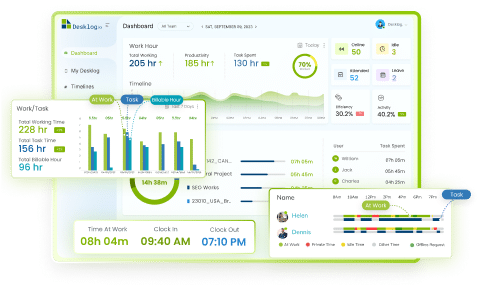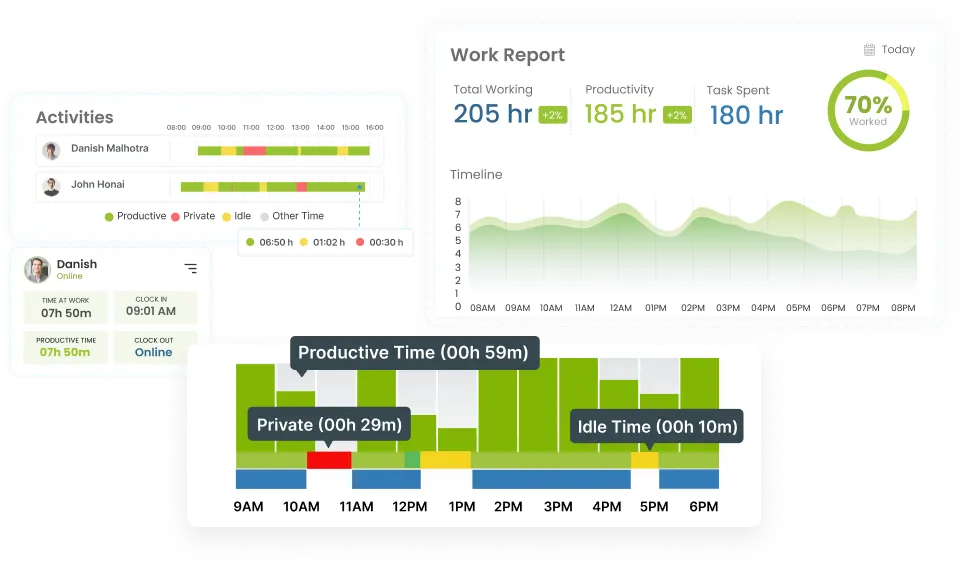Imagine you’ve just completed a major project, and it’s time to send out the bill. This is where project billing comes into play, the crucial step that ensures you get paid for your hard work. For service providers, it’s all about being fairly compensated, while clients rely on clear and accurate billing to manage their budgets and keep things running smoothly.
But let’s face it, project billing can be a real headache. Inaccurate time tracking can make things messy, lack of transparency can lead to trust issues, and slow invoicing can delay payments.
And when you’re juggling multiple projects, keeping everything organized is a real challenge. This is where technologies such as time tracking software with project billing feature comes into place, helping you differentiate between billable and non-billable tasks. Further in the blog, we will dive into every little aspect of project billing and how project billing software can be useful.
Did you know that according to a report, only 23% of organizations use standardized project management practices
What is Project Billing ?
Project billing involves invoicing clients for work done on a particular project. It includes recording all the tasks completed, the time spent, and any expenses incurred during the project’s execution. This process ensures transparency and accuracy in financial transactions, helping both the client and the service provider understand the costs involved. Effective project billing also aids in maintaining a clear financial record for future reference and analysis.
The Eight Stages of Project Billing
Project Planning
Define the scope, set rates, and establish billing terms. This stage involves agreeing on how the project will be billed—whether by hourly rates, fixed fees, or milestones.
Time and Resource Planning
Allocate and schedule necessary resources effectively and create a project timeline.
Setting a Billing Rate
Determine rates based on labor, overhead, and desired profit, and ensure competitiveness.
Discussing the Quote and Setting a Budget
Provide a detailed cost breakdown and agree on the budget with the client, including contingency funds.
Staying on Budget While Running the Project
Monitor spending with tracking tools and adjust resources or timelines as needed to remain within budget.
Generating Invoices
Create detailed invoices that clearly outline the work completed and associated charges.
Sending Invoices
Deliver invoices promptly to clients through agreed-upon methods.
Collecting Payments
Track payments, follow up on overdue invoices, and manage payment collections efficiently.
Ready to take control of your project billing? Try Desklog today and see how it can save your time!
The Four Types of Project Billing
1. Flat Project Billing
In flat project billing, the service provider and client agree on a fixed price for the entire project, regardless of the time or resources spent, making project time tracking less critical to the billing process.
Advantages
-
Predictability : Clients know the total cost upfront, which helps in budgeting and financial planning.
-
Simplicity :Invoicing is straightforward as it involves a single amount.
Disadvantages
-
Risk for Service Providers: If the project takes longer or requires more resources than anticipated, the service provider may incur losses.
-
Scope Creep: There can be a tendency for clients to request additional work outside the agreed-upon scope without additional compensation.
2.Time and Material Billing
This billing method charges clients based on the actual time spent and materials used. It can be divided into two subcategories:
a. User Hourly Billing
Each user or team member bills their hours separately, often at different rates depending on their role or expertise. Use a project billing software to calculate the hours and bill accordingly.
Advantages
-
Fair Compensation: Service providers are paid for all the time and effort invested.
-
Flexibility: Easier to accommodate changes and additional requests from clients.
Disadvantages
-
Uncertainty for Clients: Clients may find it difficult to estimate the final cost.
-
Administrative Overhead: Requires detailed tracking and documentation of each team member’s hours.
b. Hourly Billing
Similar to user hourly billing but typically involves a single hourly rate for the entire project or for specific types of work.
Advantages
-
Transparency: Clients can see exactly how much time is spent on different tasks.
-
Adjustable: Easier to adjust for changes in project scope.
Disadvantages
-
Cost Uncertainty: Final costs can be unpredictable, making budgeting difficult for clients.
-
Efficiency Concerns: There may be less incentive for service providers to work efficiently if they are paid by the hour.
3. Milestone Billing
This method involves breaking the project into phases or milestones, with payments due upon completion of each milestone.
Advantages
-
Progress-Based Payments: Clients can see tangible results before making payments, which can build trust.
-
Risk Mitigation: Spreads the financial risk over the project duration for both parties.
Disadvantages
-
Complexity: Requires detailed planning and agreement on what constitutes the completion of each milestone.
-
Potential Delays: If one milestone is delayed, it can push back the entire project timeline.
4. Retainer Billing
Clients pay a regular, predetermined fee (e.g., monthly) for ongoing access to a service provider’s expertise and resources.
Advantages
-
Steady Income: Provides consistent revenue for the service provider.
-
Priority Access: Clients often receive priority service and quick responses.
Disadvantages
-
Scope Limitations: Retainer agreements may limit the amount of work included, leading to potential disputes over what is covered.
-
Commitment Requirement: Clients may be hesitant to commit to regular payments without assurance of the workload.
Top Four Challenges of Project Billing
1) Scope Creep
Challenge
Scope creep occurs when additional tasks or features are added to a project without corresponding adjustments to time, resources, or cost. This can lead to overruns and impact the project’s profitability.
Strategies to Overcome
-
Clear Scope Definition: Start with a detailed project plan and scope agreement, clearly outlining deliverables and boundaries.
-
Change Management Process: Implement a formal process for handling change requests, including evaluating impact and obtaining client approval.
-
Regular Communication: Maintain open lines of communication with the client to manage expectations and discuss any necessary changes promptly.
2) Inaccurate Estimates
Challenge
Underestimating the time or resources needed for a project can lead to financial losses, rushed work, and client dissatisfaction.
Strategies to Overcome
-
Historical Data Analysis: Use data from past projects to inform estimates, considering the specific context and complexities of the current project.
-
Expert Consultation: Involve team members with relevant expertise in the estimation process to ensure an efficient assessment.
-
Buffer Time: Include contingency time in estimates to account for unforeseen challenges or delays.
3) Late Payments
Challenge
Delayed payments from clients can disrupt cash flow and impact the financial health of a business.
Strategies to Overcome
-
Clear Payment Terms: Establish and communicate clear payment terms, including due dates, penalties for late payments, and preferred payment methods, at the start of the project.
-
Automated Invoicing: Use billing software to send timely and accurate invoices, and set up automated reminders for overdue payments.
-
Client Relationship Management: Foster strong relationships with clients to encourage prompt payments and facilitate discussions if payment issues arise.
4) Resource Allocation
Challenge
Inefficient use of resources can lead to increased costs and delays, impacting the overall profitability of a project.
Strategies to Overcome
-
Project Management Tools: Utilize time tracking software and other tools to track resource usage, manage schedules, and allocate tasks effectively.
-
Regular Monitoring: Conduct frequent check-ins to assess progress and adjust resource allocation as needed to stay on track.
-
Cross-Training Staff: Develop a versatile team with cross-functional skills to allow flexibility in resource deployment.
Request a demo to start improving your project billing efficiency now!
Tips for Improving Project Billing
By implementing these tips, you can streamline your project billing process, improve project tracking accuracy, and enhance client relationships, leading to more successful project outcomes.
Clearly Define the Scope of Work:
Ensure that the project contract includes a detailed description of the project scope and specific project billing terms. This helps prevent misunderstandings and scope creep.
Establish a Communication Plan:
Set up regular check-ins with clients to discuss project progress and any changes in project billing. Keeping clients informed builds trust and reduces the likelihood of disputes.
Use Time Tracking Tools:
Implement project tracking and project billing software to accurately record the time spent on each task. This ensures that all billable hours are captured and provides transparency for clients.
Invoice Promptly and Professionally:
Send invoices as soon as milestones are completed or at regular intervals. Use professional templates that clearly outline the work done and the project billing details.
Offer Flexible Payment Options:
Provide multiple payment methods (e.g., credit card, bank transfer, online payment platforms) to make it easier for clients to pay promptly.
Implement a Change Management Process:
Develop a formal process for handling changes to the project scope or timeline. This includes adjusting project billing as needed and obtaining client approval.
Set Clear Payment Terms:
Clearly state payment terms in the contract, including due dates, penalties for late payments, and any discounts for early payment. This sets expectations from the outset.
Monitor Resource Usage:
Regularly review project tracking data to ensure resources are being used efficiently. Adjust allocations as necessary to prevent overruns and keep project billing on target.
Regularly Review and Adjust Estimates:
Periodically compare project progress against initial estimates. If discrepancies arise, adjust project billing estimates and communicate changes to the client promptly.
Sign up for a free trial and see how Desklog can optimize your workflow.
Improve your project billing with desklog
Efficient project billing ensures timely invoicing and accurate payment tracking, minimizing errors and improving cash flow. With Desklog, manage your project billing and invoices with ease.
Here’s how Desklog can improve your project billing:
Time Tracking
Desklog provides automated time tracking capabilities, allowing team members to log hours spent on each task or project.
Accurate time tracking ensures that all billable hours are captured, reducing errors and discrepancies in project billing
Automated Invoicing
The tool generates automated invoices based on logged hours and project data.
Automated invoicing saves time and reduces manual errors, ensuring clients receive timely and accurate bills.
Project Tracking and Reporting
Track project progress with detailed reports and analytics.
Project tracking reports provide insights into project performance, helping you identify areas for improvement and communicate progress to clients.
Customizable Billing Rates
Set different billing rates for various tasks, team members, or projects.
Customizable rates ensure flexibility and precision in project billing, accommodating diverse client needs and project types.
Expense Tracking
Record and track expenses related to each project.
Efficient expense tracking ensures that all costs are accounted for, leading to more accurate project billing.
Integration with Other Tools
Desklog integrates with various tools and platforms for seamless data exchange.
Integration enhances workflow efficiency and allows for more streamlined project billing processes.
Conclusion
In summary, mastering project billing is essential for ensuring fair compensation and maintaining smooth client relationships. Using advanced project billing tools, you can simplify invoicing, accurately track time, and ensure timely payments, making the billing process more efficient and transparent. By understanding the different types of billing, overcoming common challenges, and implementing effective strategies, you can streamline your billing process and enhance project management.
Desklog offers the solution to simplify project billing with features like automated invoicing, detailed time tracking, and customizable billing rates.
Ready to transform your project billing process?
FAQ
1What is project billing?
Project billing is the process of setting rates, preparing invoices, and collecting payments for project work. It ensures that service providers are compensated for their efforts and clients are billed accurately.
2 What are the common types of project billing?
Common types include Flat Project Billing, Time and Material Billing (which includes User Hourly and Hourly Billing), Milestone Billing, and Retainer Billing.
3What is Flat Project Billing?
Flat Project Billing involves agreeing on a fixed price for the entire project, regardless of the time or resources spent.
4 What is Time and Material Billing?
Time and Material Billing charges clients based on the actual time spent and materials used. It includes User Hourly Billing (where team members bill separately) and Hourly Billing (a single rate for the project).
5What is Milestone Billing?
Milestone Billing breaks the project into phases or milestones, with payments due upon the completion of each phase.
6What is Retainer Billing?
Retainer Billing involves clients paying a regular, predetermined fee for ongoing access to the service provider’s expertise and resources.
7What are some common challenges in project billing?
Common challenges include scope creep, inaccurate estimates, late payments, and inefficient resource allocation.
8How can I prevent scope creep?
To prevent scope creep, clearly define the project scope, implement a change management process, and maintain regular communication with the client.
9How can I ensure accurate project estimates?
Use historical data, consult with experts, and include buffer time in your estimates to account for unforeseen challenges.
10What features does Desklog offer to improve project billing?
Desklog offers features like automated time tracking, automated invoicing, customizable billing rates to simplify project billing and enhance accuracy.

















